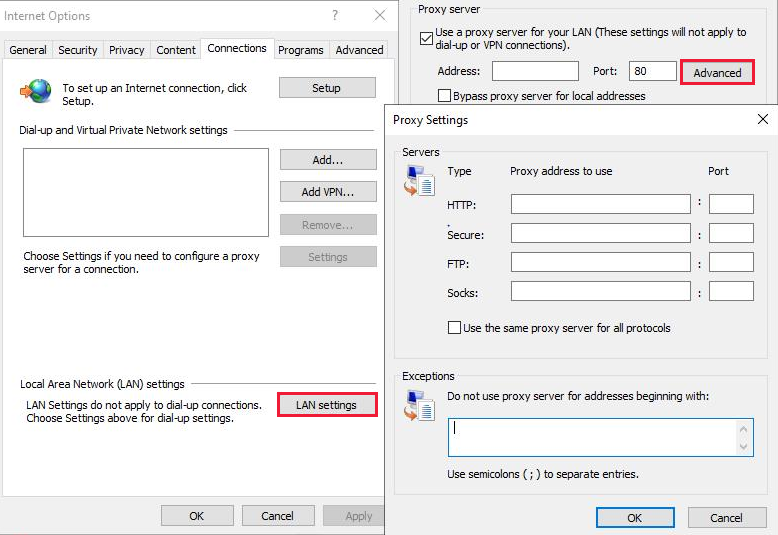Using Proxy Servers together with Internet Explorer
Warning
The retired, out-of-support Internet Explorer 11 desktop application has been permanently disabled through a Microsoft Edge update on certain versions of Windows 10. For more information, see Internet Explorer 11 desktop app retirement FAQ.
This article discusses how to use Microsoft Internet Explorer in proxy environments.
Original product version: Internet Explorer
Original KB number: 4551930
Some network requests have to bypass the proxy. The most common reason is for local (intranet) addresses. Generally, these addresses don't contain periods.
To bypass the proxy, select the Bypass proxy server for local (intranet) addresses check box in the Local Area Network (LAN) Settings dialog box. This method bypasses the proxy for all addresses that don't contain a period (for example, http://compserv). These addresses will also be resolved directly.
To bypass more complex addresses, set up exceptions for specific addresses or wildcards by using either of the following procedures.
If you're configuring proxy settings on a user's computer after the deployment, follow these steps:
In Internet Explorer, open the Tools menu, and then select Internet Options.
On the Connections tab, select LAN Settings.
In the Local Area Network Settings dialog box, select the Use a proxy server for your LAN settings check box.
Select the Advanced tab, and enter the appropriate exceptions in the Do not use proxy server for addresses beginning with: box.
Note
Multiple exceptions should be separated by semicolons (";").

For more information, see Internet Explorer uses Proxy Server for Local IP address even if the "Bypass Proxy Server for Local Addresses" option is turned on.
For more information about this method, see Use the Proxy Settings page in the IEAK 11 Wizard.
In earlier versions of the Windows operating system, Internet Explorer Maintenance (IEM) is used to configure Internet Explorer settings by using Group Policy. In Windows 8, the IEM settings have been deprecated in favor of Group Policy Preferences, Administrative Templates (.admx), and the Internet Explorer Administration Kit 10 (IEAK 10).
To configure the proxy setting through a group policy, see How to configure Proxy Settings for Internet Explorer 10 and Internet Explorer 11 as IEM is not available.
A proxy bypass entry might begin by using an http://, https://, ftp://, or gopher:// protocol type.
If a protocol type is used, the exception entry applies only to requests for that protocol.
Note
The protocol value is case insensitive. Multiple entries should be separated by semicolons.
If no protocol is specified, any request that uses the address will be bypassed.
If a protocol is specified, requests that use the address will be bypassed only if they are of the indicated protocol type. Address entries are case insensitive, the same as they are for the protocol type.
If a port number is given, the request is processed only if all previous requirements are met and the request uses the specified port number.
To bypass servers, use an asterisk ("*") as a wildcard to replace actual characters in the exceptions area of the Proxy Settings dialog box.
Enter a wildcard at the beginning of an Internet address, IP address, or domain name that has a common ending. For example, use *.example.com to bypass any entries that end in .example.com, such as some.example.com and www.example.com.
Enter a wildcard in the middle of an Internet address, IP address, or domain name that has a common beginning and ending. For example, the entry www.*.com matches any entry that starts as www and ends as com.
Enter a wildcard at the end of an Internet address, IP address, or domain name that has a common beginning. For example, use www.microsoft.* to bypass any entries that begin as www.microsoft., such as
www.microsoft.com,www.microsoft.org, but notwww.microsoftcorporation.com.The list is intended to bypass servers, and not URLs. Therefore don't enter subwebs or trailing slashes, such as https://www.microsoft.com/en-us or www.microsoft.com/, as they are invalidating the whole list otherwise.
To bypass addresses that have similar patterns, use multiple wildcards. For example, use 123.1*.66.* to bypass addresses such as 123.144.66.12, 123.133.66.15, and 123.187.66.13.
Note
Use wildcards carefully. For example, the entry www.*.com causes Internet Explorer to bypass the proxy for most websites.
If you bypass the proxy for a local domain, use *.domain.com. This method doesn't use the proxy for any computer name that ends in .domain.com. You can use the wildcard for any part of the name. For more information, see The Intranet Zone.
The following is a simple PAC file:
function FindProxyForURL(url, host)
{
return "PROXY proxyserver:portnumber";
}
Note
This PAC always returns the proxy proxyserver:portnumber. For more information about how to write a PAC file and the different functions of a PAC file, see Introduction of FindProxyForURL.
- How can I configure Proxy AutoConfigURL Setting using Group Policy Preference (GPP)?
- How to use GPP Registry to uncheck automatically detect settings?
- How to configure a proxy server URL and Port using GPP Registry?
- How to configure Group Policy Preference settings for Internet Explorer 11 in Windows 8.1 or Windows Server 2012 R2
Third-party information disclaimer
The third-party products that this article discusses are manufactured by companies that are independent of Microsoft. Microsoft makes no warranty, implied or otherwise, about the performance or reliability of these products.